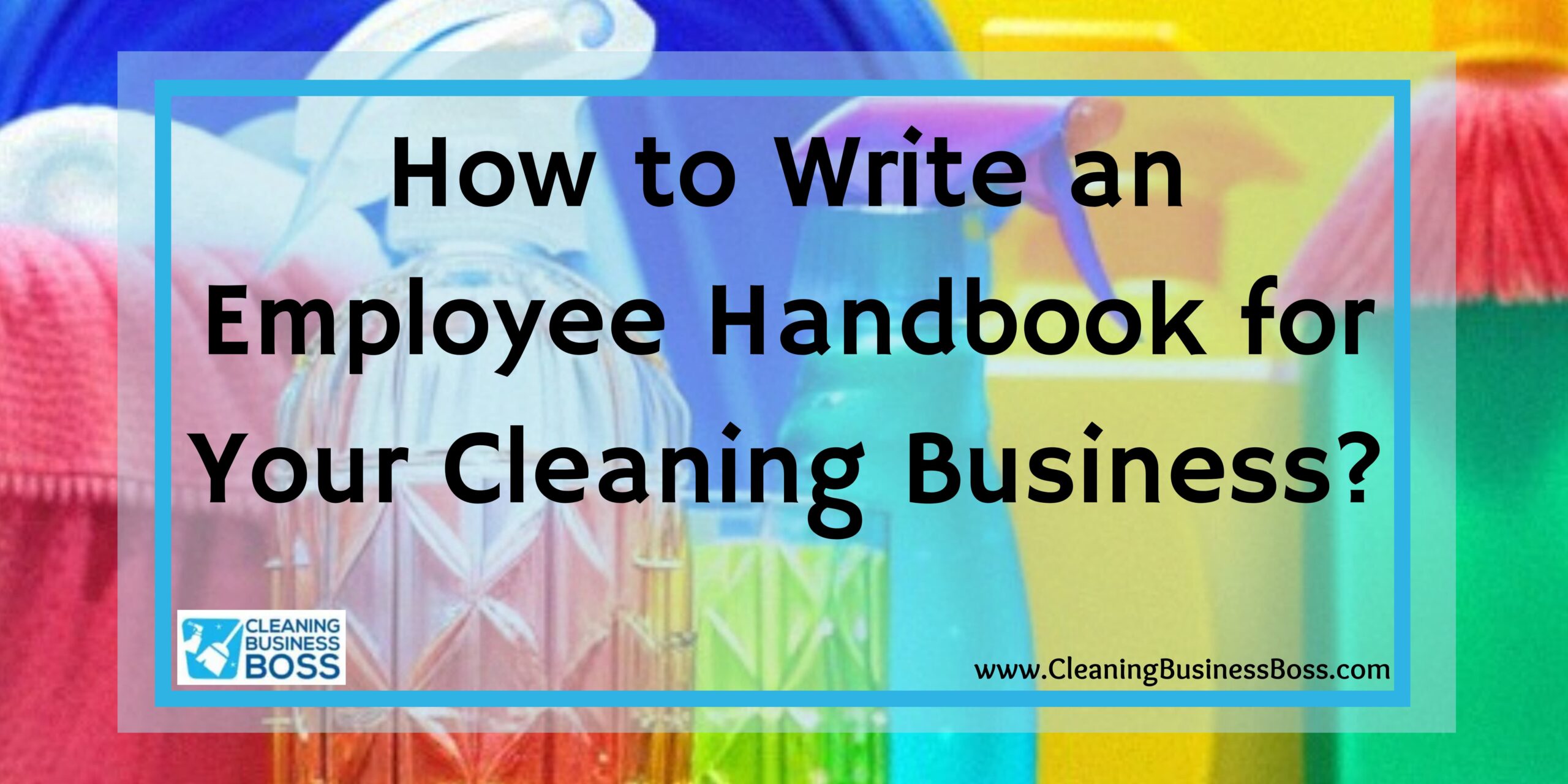If you’ve started your own cleaning business and are looking for an efficient way to train newly hired employees, then writing an employee handbook is a great way to get this done. An employee handbook — or employee manual — is an important document that outlines your company policies, history, and culture for both current and future employees.
Top 6 Policies to Include in Your Employee Handbook
- Onboarding Process
- Code of Conduct
- Health and Safety
- Compensation and Performance Reviews
- Communication Policies
- Attendance
Most experts agree that — while many small businesses only write employee handbooks — ideally, one should write their employee handbook as soon as they hire their first employee. This is because it defines expectations early on and can protect you legally. In this article, we’re going to cover six policies that you should definitely put into your employee handbook.
Onboarding Process
One of the top motivations for a cleaning business to write an employee handbook is the ability to quickly be able to train new hires. So, it’s important to start things off by laying out the basics that every employee should know before they start their first day in the service industry.
The first thing your onboarding section should include is an at-will employment clause. An ‘at-will employment clause’ is a term used in U.S. labor law for contractual relationships in which an employee can be dismissed by an employer for any reason and at any time as long as the reason is not illegal (i.e fired based on race, religion, or sexuality).
Just as workers can quit their job at any given moment for any given reason, an employer is equally allowed to do fire them in the same way (except under the pretense of race, religion, or sexuality).
The next is a confidentiality agreement. A confidentiality agreement, also known as a non-disclosure agreement (NDA), is a contract that prevents the employee from revealing confidential information about the business.
These agreements cannot be broad, but rather they must list specifically what information employees are not allowed to disclose. However, NDA’s cannot be used to prevent employees from speaking out about unethical working conditions.
These employee-based confidentiality agreements are used to protect what you would consider confidential information about your cleaning business. Needless to say, this portion of your onboarding section is unique to your business.
The last thing that you want to include in your onboarding section is the general details that new hires would need to know. This could include information about team structure and key contacts.
Check out our to know if you still need to have a business license if you want to clean houses.
Code of Conduct

All businesses have their boundaries and guidelines. Your company’s code of conduct should spell out these guidelines in the clearest and most concise way possible. If there is anything that you, as the business owner, would frown upon, then you should cover it in your code of conduct.
We understand that is a very broad task so here are a few policy guidelines that all companies should have in their code of conduct:
- Anti-discrimination policy
- Anti-harassment policy
- Dress code policy
- Substance free workplace policy
Given that this article is tailored for companies that specialize in the cleaning industry, we suggest also adding a few policies on how employees carry themselves while doing a very physical job.
Health and Safety
All businesses, but specifically cleaning businesses (because of the type of work they do), must have a well-detailed health and safety policy. The most popular approach is to divide this policy into three different sections:
- General policy on the health and safety at the workplace
- Responsibility section
- Arrangements section
For the general policy, you basically want to clearly and concisely outline your commitment to managing health and safety at your workplace effectively. As a cleaning company this can be difficult because your workplace is whatever home or apartment that you’re cleaning.
Therefore, it might be better to outline your commitment to keeping your workers safe by providing a variety of precautions and procedures that your employees must go through, prior to cleaning a home or apartment.
This leads us directly into the responsibility section of this policy. The responsibility section is meant to detail exactly who carries the burden of ensuring the health and safety of the business.
In this case, the burden would fall onto each individual employee, but you could also state that it is the manager’s or supervisor’s job to ensure that each employee is following proper health and safety precautions prior to each job.
Lastly, and arguably the most important portion of this policy, is the arrangements section. This section clearly details the actions that workers must take in order to meet the health and safety standards outlined in the general policy.
For a cleaning company, this could include but is certainly not limited to:
- Wearing gloves or masks when cleaning
- Establishing proper arrangements for the use, handling, and storage equipment or cleaning chemicals provided for use at work
- Carrying out risk assessments when necessary
- Providing employees with the necessary training and supervision to adequately complete tasks
Check out this article to learn more about business insurance and bonding.
Compensation and Performance Reviews

While all these sections are important, this is most likely the section that your employees will flip back to more than once.
Here are some things you can expect to cover in this section of your handbook:
- Payroll schedule
- Salary and bonuses
Creating a payroll schedule might seem like a task that you can easily push off to the side; because, at first glance, it might not be that important. However, there’s actually a lot riding on it.
If you don’t pay your employees frequently enough, they won’t be able to confidently plan for the future and might look for employment elsewhere. On the flip side, if you pay your employees too frequently you might be giving out more money than you have coming in and that could really backfire on you.
If you want to learn how to create the best payroll schedule feel free to check this link out.
Salaries and bonuses are also crucial aspects to your compensation policy. Based on your specific business model, you might want to consider an hourly wage or a flat fee for every residence that your employees clean.
It can be daunting to try and figure out how much to pay your employees, because — while you want to hire the best people and treat them well — you also have a bottom line to think about. Just like with your payroll schedule, if you overpay your workers you risk not being able to pay for other expenses; however, if you pay them too little then you risk losing your workers as they look for better paying jobs.
The most efficient way to determine your workers’ salaries would be to first identify your payment model (hourly, flat fee per residence, etc.) and then start crunching the numbers. Check to see the average rate of pay that is offered for a certain job by different companies and get a realistic baseline.
Communication Policies

There are certain questions that every new employee needs to know before they can become familiar with the business. Most of those questions revolve around communication. How does your team interact with each other? Do you use a messaging app? What about a messaging app for customers?
Your aim is to answer those questions in this section. While we understand that this can be considered common sense it can still be helpful to clarify it in your employee handbook.
Attendance
Writing an attendance policy is important because it explains when employees are expected to arrive for a shift, but also — and probably more importantly — it explains the guidelines for calling in sick. For example, some companies mandate that an employee must call in 4 hours in advance to let their supervisors know that they will be absent.
An attendance policy also details the consequences of unexcused absences. For instance, does an unexcused absence have to be reported to the supervisor immediately? Can it result in termination? These are the types of questions that your attendance policy should cover within your employee handbook.
Frequently Asked Questions
Should I make a section dedicated to the course of action taken when someone is terminated or quits?
Yes. That’s a great idea! You should definitely explain the offboarding process in your employee handbook. We recommend to just start by covering the offboarding basics. Try and answer these questions in your offboarding section:
- When will your former employee receive their final paycheck?
- How will the exit interviews work?
Like many other termination laws, when your former employee receives their final paycheck is heavily dependent on the state that you do business in. Almost every state has a law that answers this question in a lot of detail.
What are some other sections that I should cover in my employee handbook?
In addition to the sections we addressed in this article, you could devote sections to the following:
- The benefits of working at your company (i.e. paid time off and other leave policies)
- Office environment (work hours, use of company equipment etc.)
- Your company’s story
If you’re struggling with formatting your handbook here’s a free template that might help
Sources
Chhajer, Vipul, and Elizabeth Robinson. “The Top 8 Policies to Include in Your Employee Handbook.” Gusto, 1 Nov. 2019, gusto.com/blog/people-management/what-include-employee-handbook.
To learn more on how to start your own cleaning business, check out my startup documents here.
Please note that the contents of this blog are for informational and entertainment purposes only and should not be construed as legal advice. Any action taken based on the information provided in this blog is solely at your own risk. Additionally, all images used in this blog are generated under the CC0 license of Creative Commons, which means they are free to use for any purpose without attribution.

About the author. Entrepreneur and Cleaning Business Fan.
Hi! I am Shawn and I am a happy individual who happens to be an entrepreneur. I have owned several types of businesses in my life from a coffee shop to an import and export business to an online review business plus a few more and now I create online cleaning business resources for those interested in starting new ventures. It’s demanding work but I love it. I do it for those passionate about their business and their goals. That’s why when I meet a cleaning business owner, I see myself. I know how hard the struggle is to retain clients, find good employees and keep the business growing all while trying to stay competitive.
That’s why I created Cleaning Business Boss: I want to help cleaning business owners like you build a thriving business that brings you endless joy and supports your ideal lifestyle.


1 thought on “How to Write an Employee Handbook for Your Cleaning Business?”
Comments are closed.